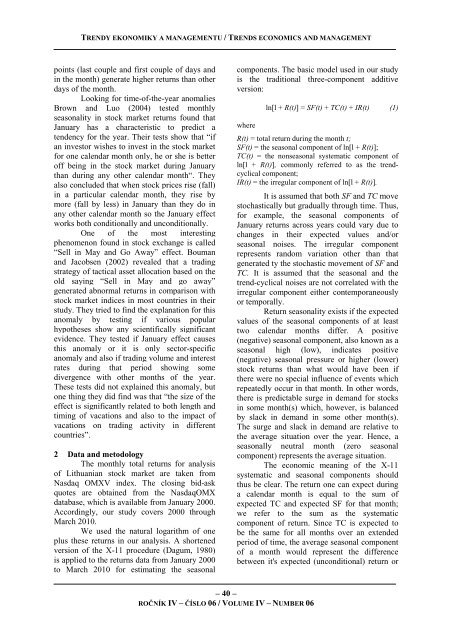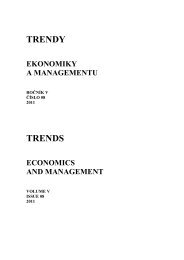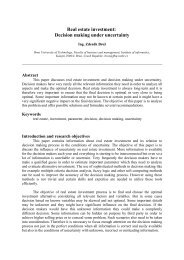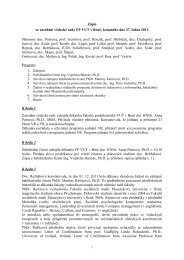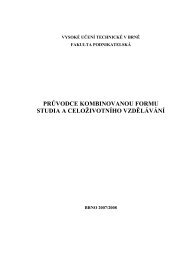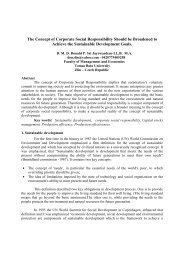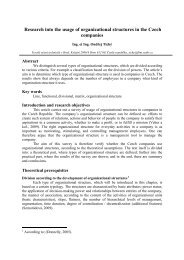Stáhnout toto číslo ve formátu PDF - Fakulta podnikatelská - Vysoké ...
Stáhnout toto číslo ve formátu PDF - Fakulta podnikatelská - Vysoké ...
Stáhnout toto číslo ve formátu PDF - Fakulta podnikatelská - Vysoké ...
You also want an ePaper? Increase the reach of your titles
YUMPU automatically turns print PDFs into web optimized ePapers that Google loves.
TRENDY EKONOMIKY A MANAGEMENTU / TRENDS ECONOMICS AND MANAGEMENT<br />
points (last couple and first couple of days and<br />
in the month) generate higher returns than other<br />
days of the month.<br />
Looking for time-of-the-year anomalies<br />
Brown and Luo (2004) tested monthly<br />
seasonality in stock market returns found that<br />
January has a characteristic to predict a<br />
tendency for the year. Their tests show that “if<br />
an in<strong>ve</strong>stor wishes to in<strong>ve</strong>st in the stock market<br />
for one calendar month only, he or she is better<br />
off being in the stock market during January<br />
than during any other calendar month“. They<br />
also concluded that when stock prices rise (fall)<br />
in a particular calendar month, they rise by<br />
more (fall by less) in January than they do in<br />
any other calendar month so the January effect<br />
works both conditionally and unconditionally.<br />
One of the most interesting<br />
phenomenon found in stock exchange is called<br />
“Sell in May and Go Away” effect. Bouman<br />
and Jacobsen (2002) re<strong>ve</strong>aled that a trading<br />
strategy of tactical asset allocation based on the<br />
old saying “Sell in May and go away”<br />
generated abnormal returns in comparison with<br />
stock market indices in most countries in their<br />
study. They tried to find the explanation for this<br />
anomaly by testing if various popular<br />
hypotheses show any scientifically significant<br />
evidence. They tested if January effect causes<br />
this anomaly or it is only sector-specific<br />
anomaly and also if trading volume and interest<br />
rates during that period showing some<br />
di<strong>ve</strong>rgence with other months of the year.<br />
These tests did not explained this anomaly, but<br />
one thing they did find was that “the size of the<br />
effect is significantly related to both length and<br />
timing of vacations and also to the impact of<br />
vacations on trading activity in different<br />
countries”.<br />
2 Data and metodology<br />
The monthly total returns for analysis<br />
of Lithuanian stock market are taken from<br />
Nasdaq OMXV index. The closing bid-ask<br />
quotes are obtained from the NasdaqOMX<br />
database, which is available from January 2000.<br />
Accordingly, our study co<strong>ve</strong>rs 2000 through<br />
March 2010.<br />
We used the natural logarithm of one<br />
plus these returns in our analysis. A shortened<br />
<strong>ve</strong>rsion of the X-11 procedure (Dagum, 1980)<br />
is applied to the returns data from January 2000<br />
to March 2010 for estimating the seasonal<br />
– 40 –<br />
ROČNÍK IV – ČÍSLO 06 / VOLUME IV – NUMBER 06<br />
components. The basic model used in our study<br />
is the traditional three-component additi<strong>ve</strong><br />
<strong>ve</strong>rsion:<br />
where<br />
ln[l + R(t)] = SF(t) + TC(t) + IR(t) (1)<br />
R(t) = total return during the month t;<br />
SF(t) = the seasonal component of ln[l + R(t)];<br />
TC(t) = the nonseasonal systematic component of<br />
ln[l + R(t)], commonly referred to as the trendcyclical<br />
component;<br />
IR(t) = the irregular component of ln[l + R(t)].<br />
It is assumed that both SF and TC mo<strong>ve</strong><br />
stochastically but gradually through time. Thus,<br />
for example, the seasonal components of<br />
January returns across years could vary due to<br />
changes in their expected values and/or<br />
seasonal noises. The irregular component<br />
represents random variation other than that<br />
generated ty the stochastic mo<strong>ve</strong>ment of SF and<br />
TC. It is assumed that the seasonal and the<br />
trend-cyclical noises are not correlated with the<br />
irregular component either contemporaneously<br />
or temporally.<br />
Return seasonality exists if the expected<br />
values of the seasonal components of at least<br />
two calendar months differ. A positi<strong>ve</strong><br />
(negati<strong>ve</strong>) seasonal component, also known as a<br />
seasonal high (low), indicates positi<strong>ve</strong><br />
(negati<strong>ve</strong>) seasonal pressure or higher (lower)<br />
stock returns than what would ha<strong>ve</strong> been if<br />
there were no special influence of e<strong>ve</strong>nts which<br />
repeatedly occur in that month. In other words,<br />
there is predictable surge in demand for stocks<br />
in some month(s) which, howe<strong>ve</strong>r, is balanced<br />
by slack in demand in some other month(s).<br />
The surge and slack in demand are relati<strong>ve</strong> to<br />
the a<strong>ve</strong>rage situation o<strong>ve</strong>r the year. Hence, a<br />
seasonally neutral month (zero seasonal<br />
component) represents the a<strong>ve</strong>rage situation.<br />
The economic meaning of the X-11<br />
systematic and seasonal components should<br />
thus be clear. The return one can expect during<br />
a calendar month is equal to the sum of<br />
expected TC and expected SF for that month;<br />
we refer to the sum as the systematic<br />
component of return. Since TC is expected to<br />
be the same for all months o<strong>ve</strong>r an extended<br />
period of time, the a<strong>ve</strong>rage seasonal component<br />
of a month would represent the difference<br />
between it's expected (unconditional) return or


